A research model is essentially a framework or blueprint that guides the entire research process. It outlines the steps involved, from formulating the research question to analyzing the data and drawing conclusions. Understanding what a research model is can be crucial for anyone seeking to conduct effective research in any field, from paranormal investigations to scientific studies. Having a clear research model helps ensure a structured and systematic approach, leading to more reliable and insightful results.
Researchers often grapple with complex methodologies. Understanding how those methodologies fit into a larger framework is key. Fortunately, resources like “what is modeling in research” can help illuminate these connections. This allows researchers to see the big picture and how individual steps contribute to the overall research process. Just as researchers are figuring out how large language models work, we’re constantly refining our understanding of research models themselves.
Types of Research Models
There are various types of research models, each suited to different research objectives and contexts. Choosing the right model is a crucial first step in any research project.
Descriptive Research Model
This model aims to describe the characteristics of a phenomenon or population. It’s often used in paranormal research to document and categorize unusual occurrences. For example, a researcher might use this model to analyze reported sightings of a specific cryptid, documenting details like location, time, and witness descriptions.
Explanatory Research Model
This model goes beyond description and seeks to explain the relationships between variables. It’s often used to understand the causes and effects of phenomena. In paranormal research, this could involve investigating the link between environmental factors and reported ghost sightings.
Predictive Research Model
This model aims to forecast future outcomes based on past data and trends. While challenging in the paranormal realm, it can be applied to predict potential hotspots of paranormal activity based on historical data.
Action Research Model
This model is cyclical and involves continuous reflection and refinement. It’s often used in applied settings to address practical problems. In paranormal research, this could involve testing different methods for communicating with spirits and adjusting the approach based on the results. This aligns with the concepts explored in resources like the “action research model”. For further insights into this approach, especially within organizational development, you can refer to the “action research model in od”.
Other Models
Beyond these core models, other specialized models exist, such as the grounded theory model, which aims to develop theories based on data collected from the field.
Choosing the Right Research Model
Selecting the appropriate research model depends on the research question and the nature of the phenomenon being studied. Considering the specific goals and limitations of the research is crucial. Sometimes, a combination of models is the most effective approach.
 Choosing the Right Research Model for Paranormal Studies
Choosing the Right Research Model for Paranormal Studies
Applying Research Models in Paranormal Investigations
The application of research models in paranormal investigations can add rigor and structure to a field often characterized by anecdotal evidence. By adopting a systematic approach, researchers can enhance the credibility of their findings. This can involve using quantitative data alongside qualitative observations, ensuring a more balanced and comprehensive investigation. While researching classic cars like the “2022 chevrolet model research,” might seem vastly different, the underlying principles of structured inquiry remain the same.
Dr. Evelyn Reed, a renowned parapsychologist, emphasizes, “Structured investigation, guided by a clear research model, is paramount in the field of paranormal research. It allows us to move beyond speculation and towards a more evidence-based understanding of these enigmatic phenomena.”
 Applying Research Models in Paranormal Investigations
Applying Research Models in Paranormal Investigations
Conclusion
Understanding what the research model is and how to apply it effectively is crucial for any researcher, regardless of the field. By carefully selecting and implementing the appropriate model, researchers can ensure a structured, systematic approach that leads to more reliable and insightful results. This allows us to move closer to understanding the mysteries of the universe, whether they lie in the realm of the paranormal or the tangible world. Embracing a robust research model strengthens our ability to explore the unknown.
FAQ
- What is the purpose of a research model? (A research model provides a framework and guides the research process.)
- What are the different types of research models? (Descriptive, explanatory, predictive, and action research are some common types.)
- How do I choose the right research model? (Consider the research question, data available, and desired outcome.)
- Can I combine different research models? (Yes, combining models can be effective in some cases.)
- Why is a research model important in Paranormal Research? (It adds rigor and structure, enhancing the credibility of findings.)
- What are some examples of research models in action? (Analyzing cryptid sightings using a descriptive model or testing communication methods with spirits using an action research model.)
- How can I learn more about specific research models? (Consult academic resources and research methodology textbooks.)
Need help with your research? Contact us 24/7: Phone: 0904826292, Email: research@gmail.com or visit us at No. 31, Alley 142/7, P. Phú Viên, Bồ Đề, Long Biên, Hà Nội, Việt Nam.